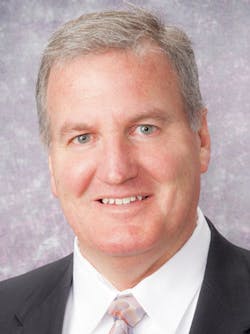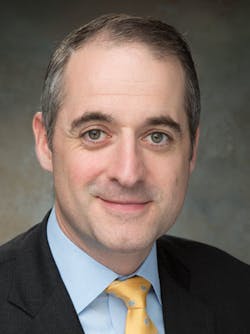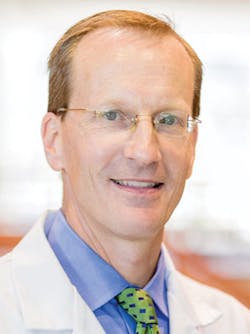Meeting in the middle to strive for optimal clinical outcomes
As healthcare economics and reform continue to tighten the grip on decision-making authority and autonomy physicians and surgeons have experienced and enjoyed for decades, doctor reactions have been swift and varied.
Within the last few years traditional consumer and trade media — as well as social media — has posted, aired and published tales of doctors burning out, selling out (to group practices, hospitals or healthcare systems) or simply getting out of practicing medicine altogether, due in large part to intensifying pressure from three key culprits: Declining reimbursement, increasing malpractice fees and claims, and shifting market referrals from payer-oriented managed care drivers.
Those who remain in the profession, however, whether employed or privileged to practice, increasingly are embracing a curious alternative to the fading status quo: Working directly with Supply Chain.
As Healthcare Purchasing News recognized the emerging and growing participation by genuinely engaged physicians and surgeons in the supply chain process it decided to identify and salute those key clinicians truly making a difference by presenting them with its annual P.U.R.E. award and profiling their points of view. P.U.R.E. signifies Physicians Understanding, Respecting and Engaging Supply Chain professionals. HPN bestows its P.U.R.E. award on those physicians and surgeons who have made solid contributions to supply chain operations — activities, practices and thinking. HPN designed it to further solidify and strengthen the clinical bonds between physicians and supply chain professionals.
Last year HPN selected three physicians to receive the third annual P.U.R.E. award. This year four more join their ranks, selected from noteworthy nominations submitted to HPN.
HPN’s 2019 Supply Chain-Focused physicians are: Ronald M. Benoit, MD, Associate Professor of Urology, University of Pittsburgh School of Medicine, and Director of General Urology, UPMC, Pittsburgh; John Cherf, MD, MPH, MBA, Chief Medical Officer, Lumere Inc., and former Chief of Orthopedics, Advocate Illinois Masonic Medical Center, Chicago; Patrick A. Kenney, MD, MPH, MBA, Assistant Professor of Urology, Yale School of Medicine, Clinical Vice Chair, Yale Medicine Urology, and Medical Director, Supply Chain, Yale New Haven Health, New Haven, CT; and John M. Mohart, MD, Vice President, Cardiovascular Care Performance Acceleration, Mercy, St. Louis.
Benoit recognizes the “extremely delicate task” Supply Chain teams have when trying to work with doctors to manage physician preference items. Supply Chain simply needs a physician champion to nurture trusted relationships, foster transparency and promote a team-based culture with the physicians, according to Benoit. So that’s what he volunteered to do in leading the value analysis team back in May 2016. Under his leadership and physician coaching, UPMC has generated hundreds of thousands of dollars in savings from removing high-cost, clinically equivalent items, tracking disposable product expenses and overall case costs.
Having earned an MBA, Cherf recognized several decades ago the importance and value of optimizing supply costs in a private practice environment, which he helped expand into a fully integrated musculoskeletal center offering a variety of services. He also helped set up two ambulatory surgery centers that “required meticulous attention to supply costs.” At mid-career, Cherf helped found the orthopedic department at a private orthopedic surgery/neurosurgery specialty hospital in Chicago that involved working with administration and Supply Chain to control costs. Before joining Lumere where he worked with hospital and health system clients to manage PPI and reduce costly clinical practice variation, he served as Chief of Orthopedics at Advocate Illinois Masonic Medical Center where he collaborated with Supply Chain and helped evaluate and introduce new technology into the Advocate Health Care system.
As part of Yale New Haven’s Corporate Supply Chain leadership team, Kenney reinforces the ongoing aim of improving clinical value by clinically integrating supply chain decision-making through value analysis for supply and service consumption. Through the Northeast Purchasing Coalition, a Vizient Member Business Venture comprising 19 members representing more than 100 acute care facilities across nine states generating $4.7 billion in annual purchasing volume, Kenney has fostered and maintained a system driven by regional clinician and physician input on clinical practices and product and service sourcing decisions. He and his team promote evidence-based decision-making related to supply and service selection and use. Kenney also is developing a national forum for Clinical Supply Integration Practice Sharing.
Mohart may be a Mercy-employed cardiovascular executive and cardiologist affiliated with multiple hospitals within the St. Louis metropolitan area, but he actually began his career as a CPA with the accounting and consulting firm Ernst & Young for nine years before switching to medicine. Mohart’s business background reinforces his clinical experience, which enabled him to meld a diverse group of physicians within the Mercy system to unify when evaluating products, protocols and services through a lens of fiscal responsibility, clinical quality and patient outcomes. His leadership efforts, for example, helped Mercy reduce CV product spending (including cardiac stents, balloons and implantable rhythm devices) by $10 million annually during the last two years. He also established a district council to focus on quality and outcomes, a ministry-wide CV summit three months ago to share best practices and strategic direction among facilities, and an electronic risk calculator for pre-cardiac surgery in which doctors can discuss with patients treatment options and protocols and determine together how to proceed.
HPN’s traditional wide-ranging interview explored how all four recognized the need for and value of supply chain strategies and tactics as an integral component of effective and efficient patient care and a critical contributor to optimal outcomes.
Associate Professor of Urology, University of Pittsburgh School of Medicine
Director of General Urology, UPMC
Pittsburgh, PA
HPN: Why do you feel it has been — and in spots still is — so difficult for physicians and surgeons to become more directly involved in supply chain issues? What are some of the challenges that doctors may have with Supply Chain (the department) that makes them so resistant to Supply Chain advice and recommendations?
BENOIT: I believe the main issue is physicians have not previously had to focus on the costs of the case they are performing. Their sole focus has been outcomes. Physicians see themselves as responsible only for outcomes, and the costs associated with the case is someone else’s concern. As to the second part of your question, physicians have the experience in the OR and believe they know which equipment works best for them. They are quite resistant to being told by non-medical personnel which equipment they should use.
Let’s reflect on the how, when and why you decided to get involved with supply chain issues? What motivated your interest?
I have an interest in healthcare costs and healthcare reform. I have used that interest to investigate areas we can decrease health care costs without impacting quality.
One major sticking point between Supply Chain and physicians has been product brand preference. Why do you believe physicians are so reluctant to change product brands if/when necessary?
Great question. Physicians, with good reason, concentrate entirely on outcomes. If a certain piece of equipment works for them, they are extremely reluctant to change devices. Brand preference oftentimes becomes more faith than reason.
Where do you see the physician’s/surgeon’s relationship with Supply Chain heading long-term?
I do believe the relationship will become more collaborative over time. As compensation becomes more value- and less volume-based, physicians will see the benefit of cost control providing we can realize cost savings without affecting outcomes.
How does having a physician or surgeon on the Supply Chain staff — or even leading the department — affect the dynamic between the two areas as well as the fiscal health of the organization?
Physicians serve an extremely valuable role as a liaison between Supply Chain and physicians. Our value is to explain the perspective of each side to the other and provide confidence everyone is acting in good faith. Progress cannot be made until these parameters have been established.
Dr. Benoit, as a urologist who leads value analysis efforts at your facility, how do you bridge the divide between your clinical peers and colleagues, Finance and Supply Chain so that everyone interlinks and works together?
Our goal is to focus on collaboration. We attempt to gain as much input from physicians as possible, and give them a range of options rather than dictating which equipment they need to use. Similarly, I also believe it is just as important to explain to Finance and Supply Chain the physicians’ perspective.
CHERF IN REAL LIFE
Unlikely source of inspiration: Not accepting or adopting the latest trend in healthcare (largely driven by stubbornness and luck).
Most creative thing he’s ever done: Professionally, building a fully integrated orthopedic institute in the early 1990s — way before this became popular. And going to business school. Personally, marrying my wife.
What makes him laugh: People making fun of themselves.
Best and worst advice someone ever gave him: Best: Founding a surgery center; Worst: Founding a specialty hospital.
Favorite objects he keeps in his office: Trout Unlimited and Pheasants Forever calendars — Great outdoor photos that provide inspiration to balance work with favorite hobbies. Photos of my family — reminds me of what is most important.
What he would tell himself if he traveled back in time to when he just started in healthcare: Think long-term rather than short-term.
JOHN CHERF, MD, MPH, MBAChief Medical Officer, Lumere
Former Chief of Orthopedics, Advocate Illinois Masonic Medical Center
Chicago, IL
HPN: Why do you feel it has been — and in spots still is — so difficult for physicians and surgeons to become more directly involved in supply chain issues? What are some of the challenges that doctors may have with Supply Chain (the department) that makes them so resistant to Supply Chain advice and recommendations?
CHERF: Many physicians and surgeons (physicians) are challenged running their own practices. Overwhelming demands for practicing medicine include government and payer compliance requirements, EHR, contracting, decreased reimbursement, etc. It is difficult for physicians to take on another responsibility that does not directly impact their workload, such as supply chain. Supply chain activities are also not part of most physicians training and are not a typical physician core competency.
Physicians rarely ask hospital administration to help control costs in their practices, and it is unclear if hospitals would deploy resources to help physician practices. We shouldn’t be surprised that physicians do not welcome the opportunity to contribute to supply chain activities in many settings. However, hospital employment of physicians and new payment models, such as bundled payments, are incentivizing physicians to spend more time managing traditional hospital costs and they take on more longitudinal financial risk.
Let’s reflect on the how, when and why you decided to get involved with supply chain issues? What motivated your interest?
One of the irrational expense problems I see in healthcare involves supply chain materials. The price discrimination we see in the global market is extreme with the U.S. paying some of the highest prices in the world. This occurs at a time when the cost of care is the single most important problem with our healthcare system. Many supply prices have increased much faster than inflation and substantially faster than physician reimbursement. This disconnect motivated me to learn more and participate in supply chain activities.
One major sticking point between Supply Chain and physicians has been product brand preference. Why do you believe physicians are so reluctant to change product brands if/when necessary?
Many physicians become entrenched with a particular device and manufacturer. This creates “stickiness” between the product and often the sales representative. The manufacturer also helps physicians with education and procedural support. The “switching costs” of changing brands can be significant. Physicians are often up on the learning curve for using a particular device. This may be a product of their training. There is also an established relationship with the rep and an overall comfort level for the physician. Giving this up can be difficult. Changing brands and devices may also adversely impact clinical outcomes as a physician moves up the learning curve with a new device. It is important to remember the physician is the stakeholder most responsible for outcomes and liable for suboptimal results. This often leads to a high threshold for physicians to change brands and devices.
Where do you see the physician’s/surgeon’s relationship with Supply Chain heading long-term?
As we transition to more overall integration between providers and increasing financial pressure to provide value-based care, physicians will likely have a greater role in supply chain activities. This will be driven by new payment models and the need to document value with optimal quality and cost to be competitive in a consumer driven market. Our conversation with physician involvement with supply chain will be very different in five and 10 years. We should expect much more physician involvement in supply chain activities and more published research in physician literature about cost of care, clinical variation and value.
How does having a physician or surgeon on the Supply Chain staff — or even leading the department — affect the dynamic between the two areas as well as the fiscal health of the organization?
Having a physician at the supply chain table is very important and extremely valuable. Physicians can provide sound clinical input to help drive supply chain efficiency. Forward-thinking organizations are integrating physicians in value analysis, clinical efficiency and other supply chain-related activities.
Dr. Cherf, as an orthopedic surgeon and clinical leader with an MBA, what do you feel is the biggest stumbling block Supply Chain has with orthopedic surgeons or even the weakest link that prevents them from working together and how might that be overcome?
I see two major stumbling blocks: Supply Chain staffs are territorial and may be intimidated by working with physicians. Ironically, the Supply Chain team knows significantly more than physicians about purchasing, inventory management, etc. The converse is true about clinical knowledge as physicians know more than the Supply Chain team. The two parties complement each other and are stronger working together rather than independently. The key is creating incentives for collaboration.
KENNEY IN REAL LIFE
Unlikely source of inspiration: The greatest source of inspiration to our group is the individual patient — our efforts to improve care are inspired by an obligation to help patients achieve the best possible outcome and to do so in a manner that respects stewardship of resources.
What makes him laugh: My family. They are wonderful to be around.
Favorite object he keeps in his office: A vibrant, fun painting of a kidney with a bandage on it. It was painted by a friend of a patient on whom I performed a complex partial nephrectomy. It has a great energy to it — and is a daily reminder to me of the importance of the work we do every day.
What he would tell himself if he traveled back in time to when he just started in healthcare: Being a physician is the most rewarding job imaginable. It is a great privilege and honor both to care for patients and to work to improve our processes of care.
PATRICK A. KENNEY, MD, MPH, MBAAssistant Professor of Urology, Yale School of Medicine, Clinical Vice Chair, Yale Medicine Urology, Medical Director, Supply Chain, Yale New Haven Health
New Haven, CT
HPN: Why do you feel it has been — and in spots still is — so difficult for physicians and surgeons to become more directly involved in supply chain issues? What are some of the challenges that doctors may have with Supply Chain (the department) that makes them so resistant to Supply Chain advice and recommendations?
KENNEY: Physicians and surgeons are incredibly busy. We are in an era of declining reimbursements, electronic medical records, and physician burnout in the setting of ever-increasing time and productivity demands. Most physicians do not have training or experience in the operational aspects of running the healthcare business. Supply chain, as traditionally framed, is not front and center in the minds of physicians — despite the fact that it impacts every aspect of their work and the care of their patients. Moreover, many hospital systems have not recognized the importance of a clinically integrated supply chain with a clinician leader. Yale New Haven Health System has been a trailblazer in this area, with both a pharmacist and a physician helping lead our efforts.
Physician Preference Items are a challenging area. There are numerous reasons why physicians may be resistant to Supply Chain advice. In many instances, physicians may be insulated from the financial ramifications of the clinical decisions they make. We often cite the “value equation” when discussing healthcare decision-making, but this is a theoretical construct. The scientific literature is imperfect and much of it is not reproducible. In particular, the evidence to support one medical device over another is often nonexistent or of very poor quality.
Physicians also do not know the cost of the items they use — but it is not their fault. The system is really stacked against us. Costs vary from one hospital to another. Confidentiality clauses prohibit price disclosure. Rebates and other factors make the actual cost of the item potentially unknowable at the time an item is used. In addition, there are data to support the notion that physicians tend to overestimate the cost of inexpensive items and underestimate the cost of expensive items. This leads them to underestimate the cost savings that could be achieved by switching to a less costly device.
Good communication is essential. It is more common for physicians to have a close relationship with industry representatives than with Supply Chain. Communication and transparency are essential to driving change. If we look to the techniques of our industry partners, we can learn what it takes to drive physician behavior change — communication, relationships, and, where appropriate, financial alignment.
Ultimately, the problem comes down to the low-value decisions made by individual physicians for their own patients. These decisions are leading to catastrophically rising costs in the U.S., with spending approaching 20 percent of GDP, an unsustainable level. We have not linked the individual decision to the aggregate consequence — a concept known as the “tragedy of the commons.” We need to resolve this problem through price and outcome transparency and by ensuring the physician incentives are aligned with value.
Let’s reflect on the how, when and why you decided to get involved with supply chain issues? What motivated your interest?
I believe that physicians are uniquely qualified to help address the operational challenges we face in health care delivery. I’ve always been interested in process improvement and how structure and process design can be used to improve performance. Although I’m in academic medicine, I’m most interested in implementation of practical, real-world approaches that impact patients now. I jumped at the chance to join Yale New Haven Corporate Supply Chain, where extraordinarily talented and hard-working people are on the front lines solving practical problems to ensure we deliver the best care — care that is both innovative and high value.
One major sticking point between Supply Chain and physicians has been product brand preference. Why do you believe physicians are so reluctant to change product brands if/when necessary?
There are far more contributing factors than just reluctance on the part of physicians. Outside of supply chain, there is abundant and oft-cited literature documenting slow diffusion of practice change and poor compliance [with] best practices and guidelines. Nonetheless, I dispute the notion that physicians are generally reluctant to change. There are examples of seismic changes in clinical practice and very rapid adoption of new technology. We know that physicians can change practice rapidly — but we need to better understand what motivates these changes.
I suspect that high-quality literature and a desire to improve outcomes is a strong motivator of change. There are also nice data to show that physicians respond to incentives and to personal relationships — facts which are well-known to our partners in industry. We’ve all seen previously unwavering orthopedic surgeons switch to a new vendor when their rep changes employers. I definitely do not know the roadmap to solve PPI — but it most definitely includes better communication and engagement with physicians, potentiation of value-based decision making through transparency in cost and outcomes, and appropriate incentives to make the right choice.
Most importantly, though, we have to understand physicians and what informs their preferences. Physicians and surgeons work in a high-stakes environment. Every decision and every surgical maneuver can have profound consequences for our patients. Familiarity with a drug or device, and their nuances, brings a measure of stability and reproducibility. We are still trained as artisans. When a surgeon has performed a high-stakes operation, for instance, sewing a graft to a great vessel hundreds or thousands of times with good results, the proposed potential benefit of switching to a new, unknown suture for which there is little comparative evidence will have to be very high in order for the surgeon to be an eager participant.
Where do you see the physician’s/surgeon’s relationship with Supply Chain heading long-term?
Long-term, I envision a clinically integrated supply chain characterized by seamless communication and transparency in pricing, outcomes and relative performance. Supply Chain needs to do more than just procure what it is that physicians want — Supply Chain needs to provide decision support to help physicians establish or change a preference.
How does having a physician or surgeon on the Supply Chain staff — or even leading the department — affect the dynamic between the two areas as well as the fiscal health of the organization?
In part, a physician can act as intermediary between Supply Chain and the Medical Staff, and ensure that we are all working together toward a common goal. The hope is to create a very positive dynamic, to help advance the supply chain value and safety agenda, and to ensure that the needs of our physicians and patients are met. I often note that patients come to our medical center for our outstanding physicians — they rarely come for access to a device. It is our physicians that are the highly differentiated product — most of the devices are branded commodities. Sometimes it is easy to forget this.
Devices and new technology form a large portion of the rising cost of hospitalizations, and can be the dominant cost of some surgical admissions. Taming this area can produce dramatic results, and if appropriate processes and culture are put in place, the improvements can continue to bear fruit on a regular basis. More importantly, having a clinician leader in supply chain can help emphasize quality and safety. Similar to the great work done in pharmacy over the past several decades, there is an enormous amount of work to be done in supply chain with regards to safety and quality, including evaluation of new product requests, aftermarket surveillance, and regular communication with clinicians about the products we source.
Dr. Kenney, as a urological oncologist with extensive experience in robotic surgery, how do you interact with and relate to Supply Chain without intimidating anyone?
I am fortunate to be part of a great team at Yale New Haven. This organization is like sailing a big ship requiring many hands on deck — we all need to work together to chart the course, gauge the wind, and adjust the sails. Our patients benefit when we work well together as a team, and this is reflected in our organization’s values. Professionalism is a necessary ingredient for safety, for great patient care, and to create a positive work environment. To reach our goals, we need to hear from every voice. It is essential to create an environment where high reliability behaviors flourish, such as clear communication, the concept of 200 percent accountability and embrace of questioning attitudes. My office door is always open.
MOHART IN REAL LIFE
Unlikely source of inspiration: Physical labor
Most creative thing he’s ever done: Rehab of an old church on our property
What makes him laugh: My kids
Best and worst advice someone ever gave him: Best: The days go by slow but the years go fast; Worst: Tech stocks too risky
Favorite object he keeps in his office: Pictures of family
What he would tell himself if he traveled back in time to when he just started in healthcare: Be patient
JOHN M. MOHART, MDVice President, Cardiovascular Care Performance Acceleration, Mercy
St. Louis, MO
HPN: Why do you feel it has been — and in spots still is — so difficult for physicians and surgeons to become more directly involved in supply chain issues? What are some of the challenges that doctors may have with Supply Chain (the department) that makes them so resistant to Supply Chain advice and recommendations?
MOHART: In general, physicians/surgeons are occupied with caring for patients and time constraints do not always allow the opportunity for additional involvement in supply chain related activities. Non-integrated supply chain efforts can also lead to a siloed approach, often creating confusion, misconceptions, and inconsistencies among multiple departments.
While I understand that clinicians may not want to get involved in supply chain-related activities — particularly if it takes them away from their primary mission of caring for patients — how do you advise clinicians to make the delicate balance work, specifically if working on business-related matters is no longer an option but a necessity?
The delivery of healthcare is changing rapidly with new entrants and disrupters. In order for organizations to thrive and survive in the future, physicians must lead in delivering the best care and outcomes at the lowest cost.
Let’s reflect on the how, when and why you decided to get involved with supply chain issues? What motivated your interest?
We must create greater value in healthcare to our patients and our organizations. I realized the tremendous opportunity in supply chain in the cardiovascular (CV) arena.
Healthcare margins are very slim after accounting for total costs and vendors have had significant leverage over hospitals in the past. Reduction in supply costs creates dollars that flow directly to the bottom line, which can be used to invest in opportunities to deliver new and innovative ways to care for the patients we serve.
One major sticking point between Supply Chain and physicians has been product brand preference. Why do you believe physicians are so reluctant to change product brands if/when necessary?
Different physicians and healthcare professionals have varying preferences for the products that they use, and when a clinician uses a familiar product that works well and consistently delivers good outcomes, there could be some hesitancy to change that practice. Identifying product characteristics necessary for optimal care, understanding the costs associated with these products, and discussing alternatives can help uncover products or standardization efforts that will offer comparable or better outcomes with additional value.
Where do you see the physician’s/surgeon’s relationship with Supply Chain heading long-term?
Physicians/surgeons will most certainly become more involved in the supply chain process over time. Given the rising cost of healthcare coupled with the challenging reimbursement landscape, it will become essential to partner together with all departments to engage in a higher level of transparency and provide an increased focus on delivering value through a collaborative decision-making process.
How does having a physician or surgeon on the Supply Chain staff — or even leading the department — affect the dynamic between the two areas as well as the fiscal health of the organization?
Integrating a physician or surgeon on the Supply Chain staff can foster collaborative relationships to ensure patient care needs are met while deriving optimal value from the supply chain system. Having a physician or surgeon assist and support an evidenced-based decision-making process for the selection of products and standardization efforts can lead to increased clinical, financial, and operational efficiencies.
Dr. Mohart, you started your career as a CPA before changing gears to become a cardiologist. How has that accounting/financial background shaped your clinical career and helped you balance your business acumen as it relates to supply chain?
The business and accounting training has helped tremendously in analyzing options, understanding numbers and projections, P&L and realizing the impact supply chain can make on providing value to the organization.
About the Author
Rick Dana Barlow
Senior Editor
Rick Dana Barlow is Senior Editor for Healthcare Purchasing News, an Endeavor Business Media publication. He can be reached at [email protected].






